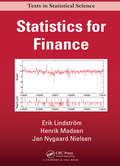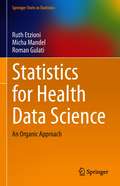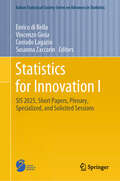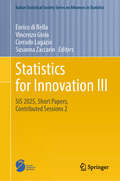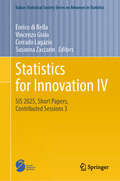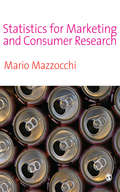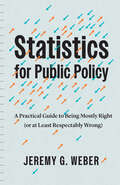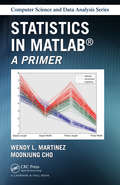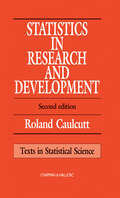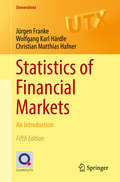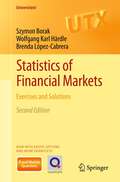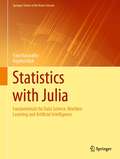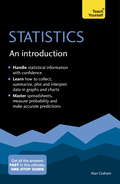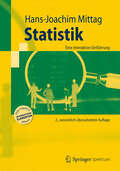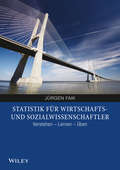- Table View
- List View
Statistics for Business and Financial Economics
by Cheng-Few Lee John C. Lee Alice C. LeeStatistics for Business and Financial Economics, 3rd edition is the definitive Business Statistics book to use Finance, Economics, and Accounting data throughout the entire book. Therefore, this book gives students an understanding of how to apply the methodology of statistics to real world situations. In particular, this book shows how descriptive statistics, probability, statistical distributions, statistical inference, regression methods, and statistical decision theory can be used to analyze individual stock price, stock index, stock rate of return, market rate of return, and decision making. In addition, this book also shows how time-series analysis and the statistical decision theory method can be used to analyze accounting and financial data. In this fully-revised edition, the real world examples have been reconfigured and sections have been edited for better understanding of the topics.
Statistics for Composite Indicators (SxI - Springer for Innovation / SxI - Springer per l'Innovazione #18)
by Matteo Mazziotta Adriano ParetoThis book provides a systematic and integrated approach to construct measures of complex and multidimensional concepts called composite indicators. One of the most pressing needs of scientists and policy makers is to measure phenomena that are important to our lives in society using numbers, to observe their evolution over time, and to analyse the relationships between them in order to understand the complex reality and decide on the right actions to achieve specific goals. Many socio-economic phenomena, as well as ecological, biological and of other sciences, are multidimensional and, to be measured, require the use of statistical-mathematical techniques that facilitate their reading and use for studies and analyses. This book is a guide to the knowledge and application of statistical tools suitable for the construction of &“optimal&” composite indicators, i.e. indicators that provide the most accurate measure of multidimensional reality. The book is aimed at all those - statisticians, sociologists, economists, and policy makers - who wish to construct composite indicators to measure and evaluate the complex reality that surrounds us.
Statistics for Finance (Chapman & Hall/CRC Texts in Statistical Science)
by Henrik Madsen Erik Lindström Jan Nygaard NielsenStatistics for Finance develops students’ professional skills in statistics with applications in finance. Developed from the authors’ courses at the Technical University of Denmark and Lund University, the text bridges the gap between classical, rigorous treatments of financial mathematics that rarely connect concepts to data and books on econometrics and time series analysis that do not cover specific problems related to option valuation. The book discusses applications of financial derivatives pertaining to risk assessment and elimination. The authors cover various statistical and mathematical techniques, including linear and nonlinear time series analysis, stochastic calculus models, stochastic differential equations, Itō’s formula, the Black–Scholes model, the generalized method-of-moments, and the Kalman filter. They explain how these tools are used to price financial derivatives, identify interest rate models, value bonds, estimate parameters, and much more. This textbook will help students understand and manage empirical research in financial engineering. It includes examples of how the statistical tools can be used to improve value-at-risk calculations and other issues. In addition, end-of-chapter exercises develop students’ financial reasoning skills.
Statistics for Health Data Science: An Organic Approach (Springer Texts in Statistics)
by Ruth Etzioni Micha Mandel Roman GulatiStudents and researchers in the health sciences are faced with greater opportunity and challenge than ever before. The opportunity stems from the explosion in publicly available data that simultaneously informs and inspires new avenues of investigation. The challenge is that the analytic tools required go far beyond the standard methods and models of basic statistics. This textbook aims to equip health care researchers with the most important elements of a modern health analytics toolkit, drawing from the fields of statistics, health econometrics, and data science. This textbook is designed to overcome students’ anxiety about data and statistics and to help them to become confident users of appropriate analytic methods for health care research studies. Methods are presented organically, with new material building naturally on what has come before. Each technique is motivated by a topical research question, explained in non-technical terms, and accompanied by engaging explanations and examples. In this way, the authors cultivate a deep (“organic”) understanding of a range of analytic techniques, their assumptions and data requirements, and their advantages and limitations. They illustrate all lessons via analyses of real data from a variety of publicly available databases, addressing relevant research questions and comparing findings to those of published studies. Ultimately, this textbook is designed to cultivate health services researchers that are thoughtful and well informed about health data science, rather than data analysts. This textbook differs from the competition in its unique blend of methods and its determination to ensure that readers gain an understanding of how, when, and why to apply them. It provides the public health researcher with a way to think analytically about scientific questions, and it offers well-founded guidance for pairing data with methods for valid analysis. Readers should feel emboldened to tackle analysis of real public datasets using traditional statistical models, health econometrics methods, and even predictive algorithms. Accompanying code and data sets are provided in an author site: https://roman-gulati.github.io/statistics-for-health-data-science/
Statistics for Innovation I: SIS 2025, Short Papers, Plenary, Specialized, and Solicited Sessions (Italian Statistical Society Series on Advances in Statistics)
by Enrico Di Bella Vincenzo Gioia Corrado Lagazio Susanna ZaccarinThis book presents peer-reviewed short papers on methodological and applied statistical research presented at the Italian Statistical Society&’s international conference on &“Statistics for Innovation&”, SIS 2025, held in Genoa, Italy, June 16-18, 2025. It is the first of four volumes, featuring invited contributions presented in the Plenary, Specialized and Solicited Sessions. Providing a comprehensive overview of innovations in modern statistical methods and applications, the volumes address a large number of topics of current interest, contributing to a rapid dissemination of quantitative methods for data analysis across the various fields of scientific research and social life. The volumes underpin the role of statistics and data science in fostering innovation in numerous fields, including business, industry, finance, technology, environment, health and medicine, official statistics, public policy, welfare, social issues and sustainable development. One of the aims of the Italian Statistical Society (SIS) is to promote scientific activities for the development of statistical sciences. Together with the biennial international Scientific Meeting, the intermediate international statistical conferences on a particular topic of interest represent the Society&’s most important events which bring together national and international researchers and professionals to exchange ideas and discuss recent advances and developments in theoretical and applied statistics.
Statistics for Innovation II: SIS 2025, Short Papers, Contributed Sessions 1 (Italian Statistical Society Series on Advances in Statistics)
by Enrico Di Bella Vincenzo Gioia Corrado Lagazio Susanna ZaccarinThis book presents peer-reviewed short papers on methodological and applied statistical research presented at the Italian Statistical Society&’s international conference on &“Statistics for Innovation&”, SIS 2025, held in Genoa, Italy, June 16-18, 2025. It is the second of four volumes, featuring the first part of the contributions presented in the Contributed Sessions. Providing a comprehensive overview of innovations in modern statistical methods and applications, the volumes address a large number of topics of current interest, contributing to a rapid dissemination of quantitative methods for data analysis across the various fields of scientific research and social life. The volumes underpin the role of statistics and data science in fostering innovation in numerous fields, including business, industry, finance, technology, environment, health and medicine, official statistics, public policy, welfare, social issues and sustainable development. One of the aims of the Italian Statistical Society (SIS) is to promote scientific activities for the development of statistical sciences. Together with the biennial international Scientific Meeting, the intermediate international statistical conferences on a particular topic of interest represent the Society&’s most important events which bring together national and international researchers and professionals to exchange ideas and discuss recent advances and developments in theoretical and applied statistics.
Statistics for Innovation III: SIS 2025, Short Papers, Contributed Sessions 2 (Italian Statistical Society Series on Advances in Statistics)
by Enrico Di Bella Vincenzo Gioia Corrado Lagazio Susanna ZaccarinThis book presents peer-reviewed short papers on methodological and applied statistical research presented at the Italian Statistical Society&’s international conference on &“Statistics for Innovation&”, SIS 2025, held in Genoa, Italy, June 16-18, 2025. It is the third of four volumes, featuring the second part of the contributions presented in the Contributed Sessions. Providing a comprehensive overview of innovations in modern statistical methods and applications, the volumes address a large number of topics of current interest, contributing to a rapid dissemination of quantitative methods for data analysis across the various fields of scientific research and social life. The volumes underpin the role of statistics and data science in fostering innovation in numerous fields, including business, industry, finance, technology, environment, health and medicine, official statistics, public policy, welfare, social issues and sustainable development. One of the aims of the Italian Statistical Society (SIS) is to promote scientific activities for the development of statistical sciences. Together with the biennial international Scientific Meeting, the intermediate international statistical conferences on a particular topic of interest represent the Society&’s most important events which bring together national and international researchers and professionals to exchange ideas and discuss recent advances and developments in theoretical and applied statistics.
Statistics for Innovation IV: SIS 2025, Short Papers, Contributed Sessions 3 (Italian Statistical Society Series on Advances in Statistics)
by Enrico Di Bella Vincenzo Gioia Corrado Lagazio Susanna ZaccarinThis book presents peer-reviewed short papers on methodological and applied statistical research presented at the Italian Statistical Society&’s international conference on &“Statistics for Innovation&”, SIS 2025, held in Genoa, Italy, June 16-18, 2025. It is the last of four volumes, featuring the third part of the contributions presented in the Contributed Sessions. Providing a comprehensive overview of innovations in modern statistical methods and applications, the volumes address a large number of topics of current interest, contributing to a rapid dissemination of quantitative methods for data analysis across the various fields of scientific research and social life. The volumes underpin the role of statistics and data science in fostering innovation in numerous fields, including business, industry, finance, technology, environment, health and medicine, official statistics, public policy, welfare, social issues and sustainable development. One of the aims of the Italian Statistical Society (SIS) is to promote scientific activities for the development of statistical sciences. Together with the biennial international Scientific Meeting, the intermediate international statistical conferences on a particular topic of interest represent the Society&’s most important events which bring together national and international researchers and professionals to exchange ideas and discuss recent advances and developments in theoretical and applied statistics.
Statistics for Managers Using Microsoft Excel
by David Levine David Stephan Kathryn Szabat<p>For undergraduate business statistics courses. Analyzing the Data Applicable to Business. This text is the gold standard for learning how to use Microsoft Excel® in business statistics, helping students gain the understanding they need to be successful in their careers. The authors present statistics in the context of specific business fields; full chapters on business analytics further prepare students for success in their professions. Current data throughout the text lets students practice analyzing the types of data they will see in their professions. The friendly writing style include tips throughout to encourage learning. <p>The book also integrates PHStat, an add-in that bolsters the statistical functions of Excel.</p>
Statistics for Marketing and Consumer Research
by Mario MazzocchiBalancing simplicity with technical rigour, this practical guide to the statistical techniques essential to research in marketing and related fields, describes each method as well as showing how they are applied. The book is accompanied by two real data sets to replicate examples and with exercises to solve, as well as detailed guidance on the use of appropriate software including: - 750 powerpoint slides with lecture notes and step-by-step guides to run analyses in SPSS (also includes screenshots) - 136 multiple choice questions for tests This is augmented by in-depth discussion of topics including: - Sampling - Data management and statistical packages - Hypothesis testing - Cluster analysis - Structural equation modelling
Statistics for Non-Statisticians
by Birger MadsenThis book was written for those who need to know how to collect, analyze and present data. It is meant to be a first course for practitioners, a book for private study or brush-up on statistics, and supplementary reading for general statistics classes. The book is untraditional, both with respect to the choice of topics and the presentation. The topics were determined by what is most useful for practical statistical work: even experienced statisticians will find new topics or new approaches to traditional topics. The presentation is as non-mathematical as possible. Mathematical formulae are presented only if they are necessary for calculations and/or add to readers' understanding. A sample survey is developed as a realistic example throughout the book, and many further examples are presented, which also use data spreadsheets from a supplementary website.
Statistics for Public Policy: A Practical Guide to Being Mostly Right (or at Least Respectably Wrong)
by Jeremy G. WeberA long-overdue guide on how to use statistics to bring clarity, not confusion, to policy work. Statistics are an essential tool for making, evaluating, and improving public policy. Statistics for Public Policy is a crash course in wielding these unruly tools to bring maximum clarity to policy work. Former White House economist Jeremy G. Weber offers an accessible voice of experience for the challenges of this work, focusing on seven core practices: Thinking big-picture about the role of data in decisions Critically engaging with data by focusing on its origins, purpose, and generalizability Understanding the strengths and limits of the simple statistics that dominate most policy discussions Developing reasons for considering a number to be practically small or large Distinguishing correlation from causation and minor causes from major causes Communicating statistics so that they are seen, understood, and believed Maintaining credibility by being right (or at least respectably wrong) in every setting Statistics for Public Policy dispenses with the opacity and technical language that have long made this space impenetrable; instead, Weber offers an essential resource for all students and professionals working at the intersections of data and policy interventions. This book is all signal, no noise.
Statistics in MATLAB: A Primer (Chapman & Hall/CRC Computer Science & Data Analysis)
by Wendy L. Martinez MoonJung ChoThis primer provides an accessible introduction to MATLAB version 8 and its extensive functionality for statistics. Fulfilling the need for a practical user's guide, the book covers capabilities in the main MATLAB package, the Statistics Toolbox, and the student version of MATLAB, presenting examples of how MATLAB can be used to analyze data. It explains how to determine what method should be used for analysis, and includes figures, visual aids, and access to a companion website with data sets and additional examples.
Statistics in Research and Development (Chapman & Hall/CRC Texts in Statistical Science)
by R. CaulcuttMany scientists and technologists would like to carry out their own statistical analyses without reference to a professional statistician. Often, however, they have no knowledge of statistics or otherwise do not know how to apply it to research and development problems. The first edition of Statistics in Research and Development was written for the
Statistics of Financial Markets
by Wolfgang Karl Härdle Jürgen Franke Christian Matthias HafnerNow in its fourth edition, this book offers a detailed yet concise introduction to the growing field of statistical applications in finance. The reader will learn the basic methods of evaluating option contracts, analyzing financial time series, selecting portfolios and managing risks based on realistic assumptions about market behavior. The focus is both on the fundamentals of mathematical finance and financial time series analysis, and on applications to given problems concerning financial markets, thus making the book the ideal basis for lectures, seminars and crash courses on the topic. For this new edition the book has been updated and extensively revised and now includes several new aspects, e. g. new chapters on long memory models, copulae and CDO valuation. Practical exercises with solutions have also been added. Both R and Matlab Code, together with the data, can be downloaded from the book's product page and www. quantlet. de
Statistics of Financial Markets: An Introduction (Universitext)
by Wolfgang Karl Härdle Jürgen Franke Christian Matthias HafnerNow in its fifth edition, this book offers a detailed yet concise introduction to the growing field of statistical applications in finance. The reader will learn the basic methods for evaluating option contracts, analyzing financial time series, selecting portfolios and managing risks based on realistic assumptions about market behavior. The focus is both on the fundamentals of mathematical finance and financial time series analysis, and on applications to specific problems concerning financial markets, thus making the book the ideal basis for lectures, seminars and crash courses on the topic. All numerical calculations are transparent and reproducible using quantlets.For this new edition the book has been updated and extensively revised and now includes several new aspects such as neural networks, deep learning, and crypto-currencies. Both R and Matlab code, together with the data, can be downloaded from the book’s product page and the Quantlet platform.The Quantlet platform quantlet.de, quantlet.com, quantlet.org is an integrated QuantNet environment consisting of different types of statistics-related documents and program codes. Its goal is to promote reproducibility and offer a platform for sharing validated knowledge native to the social web. QuantNet and the corresponding Data-Driven Documents-based visualization allow readers to reproduce the tables, pictures and calculations inside this Springer book.“This book provides an excellent introduction to the tools from probability and statistics necessary to analyze financial data. Clearly written and accessible, it will be very useful to students and practitioners alike.”Yacine Ait-Sahalia, Otto Hack 1903 Professor of Finance and Economics, Princeton University
Statistics of Financial Markets: Exercises and Solutions
by Wolfgang Karl Härdle Brenda López-Cabrera Szymon BorakPractice makes perfect. Therefore the best method of mastering models is working with them. This book contains a large collection of exercises and solutions which will help explain the statistics of financial markets. These practical examples are carefully presented and provide computational solutions to specific problems, all of which are calculated using R and Matlab. This study additionally looks at the concept of corresponding Quantlets, the name given to these program codes and which follow the name scheme SFSxyz123. The book is divided into three main parts, in which option pricing, time series analysis and advanced quantitative statistical techniques in finance is thoroughly discussed. The authors have overall successfully created the ideal balance between theoretical presentation and practical challenges.
Statistics of Quality (Statistics: A Series Of Textbooks And Monographs #153)
by SUBIR GHOSH; WILLIAM R. SCHUCANY; WILLIAM B. SMITHExplains the role of statistics in improving the quality of collecting and analyzing information for a wide variety of applications. The book examines the function of statisticians in quality improvement. It discusses statistical process control, quality statistical tables, and quality and warranty; quality standards in medicine and public health; Taguchi robust designs and survival models; and more.
Statistics with Julia: Fundamentals for Data Science, Machine Learning and Artificial Intelligence (Springer Series in the Data Sciences)
by Yoni Nazarathy Hayden KlokThis monograph uses the Julia language to guide the reader through an exploration of the fundamental concepts of probability and statistics, all with a view of mastering machine learning, data science, and artificial intelligence. The text does not require any prior statistical knowledge and only assumes a basic understanding of programming and mathematical notation. It is accessible to practitioners and researchers in data science, machine learning, bio-statistics, finance, or engineering who may wish to solidify their knowledge of probability and statistics. The book progresses through ten independent chapters starting with an introduction of Julia, and moving through basic probability, distributions, statistical inference, regression analysis, machine learning methods, and the use of Monte Carlo simulation for dynamic stochastic models. Ultimately this text introduces the Julia programming language as a computational tool, uniquely addressing end-users rather than developers. It makes heavy use of over 200 code examples to illustrate dozens of key statistical concepts. The Julia code, written in a simple format with parameters that can be easily modified, is also available for download from the book’s associated GitHub repository online.See what co-creators of the Julia language are saying about the book:Professor Alan Edelman, MIT: With “Statistics with Julia”, Yoni and Hayden have written an easy to read, well organized, modern introduction to statistics. The code may be looked at, and understood on the static pages of a book, or even better, when running live on a computer. Everything you need is here in one nicely written self-contained reference. Dr. Viral Shah, CEO of Julia Computing: Yoni and Hayden provide a modern way to learn statistics with the Julia programming language. This book has been perfected through iteration over several semesters in the classroom. It prepares the reader with two complementary skills - statistical reasoning with hands on experience and working with large datasets through training in Julia.
Statistics, New Empiricism and Society in the Era of Big Data (SpringerBriefs in Statistics)
by Giuseppe ArbiaThis book reveals the myriad aspects of Big Data collection and analysis, by defining and clarifying the meaning of Big Data and its unique characteristics in a non-technical and easy-to-follow way. Moreover, it discusses critical issues and problems related to the Big Data revolution and their implications for both Statistics as a discipline and for our everyday lives. The author identifies various problems and limitations in the quantitative analysis of Big Data, with regard to e.g. its volume, velocity and variety, as well as its reliability and veridicity. Dedicated chapters focus on the epistemological aspects of data-based knowledge and ethical aspects of the use of Big Data, while also addressing paradigmatic cases such as Cambridge Analytica and the use of data from social networks to influence election outcomes.
Statistics, Testing, and Defense Acquisition: New Approaches and Methodological Improvements
by Panel on Statistical Methods for Testing Evaluating Defense SystemsFor every weapons system being developed, the U.S. Department of Defense (DOD) must make a critical decision: Should the system go forward to full-scale production? The answer to that question may involve not only tens of billions of dollars but also the nation's security and military capabilities. In the milestone process used by DOD to answer the basic acquisition question, one component near the end of the process is operational testing, to determine if a system meets the requirements for effectiveness and suitability in realistic battlefield settings. Problems discovered at this stage can cause significant production delays and can necessitate costly system redesign.This book examines the milestone process, as well as the DOD's entire approach to testing and evaluating defense systems. It brings to the topic of defense acquisition the application of scientific statistical principles and practices.
Statistics: Teach Yourself
by Alan GrahamDo you need to gain confidence with handling numbers and formulae? Do you want a clear, step-by-step guide to the key concepts and principles of statistics? Nearly all aspects of our lives can be subject to statistical analysis. Statistics: An Introduction shows you how to interpret, analyze and present figures.Assuming minimal knowledge of maths and using examples from a wide variety of everyday contexts, this book makes often complex concepts and techniques easy to get to grips with. This new edition has been fully updated.Whether you want to understand the statistics that you are bombarded with every day or are a student or professional coming to statistics from a wide range of disciplines, Statistics: An Introduction covers it all.
Statistics: The Easy Way to Learn Stats
by Alan GrahamDo you need to gain confidence with handling numbers and formulae? Do you want a clear, step-by-step guide to the key concepts and principles of statistics? Nearly all aspects of our lives can be subject to statistical analysis. Statistics: An Introduction shows you how to interpret, analyze and present figures.Assuming minimal knowledge of maths and using examples from a wide variety of everyday contexts, this book makes often complex concepts and techniques easy to get to grips with. This new edition has been fully updated.Whether you want to understand the statistics that you are bombarded with every day or are a student or professional coming to statistics from a wide range of disciplines, Statistics: An Introduction covers it all.
Statistik
by Hans-Joachim MittagBeim Multimedia-Comenius-Wettbewerb 2011 ausgezeichnet, bietet das Lehrbuch als Kombination aus Druckwerk und interaktiver Online-Fassung eine gelungene Einführung in die Statistik. Das Anwendungsspektrum der Statistik wird anhand aktueller Beispiele illustriert, die statistischen Konzepte in Grafiken visualisiert. Der Band enthält viele Übungsaufgaben mit ausführlichen Lösungen. Die überarbeitete 2. Auflage wird durch neue interaktive Experimente und tongestützte Animationen ergänzt und bietet frei zugängliche Multimedia-Ressourcen im Internet.
Statistik für Wirtschafts- und Sozialwissenschaftler: Verstehen, Lernen, Üben
by Jürgen FaikStatistik ist ein komplexes Thema, aber es muss nicht unbedingt kompliziert erklärt werden. Jürgen Faik bringt Ihnen in diesem Buch die Statistik so verständlich wie möglich näher. Er führt Sie erst in die statistischen Grundlagen ein und widmet sich dann der deskriptiven Statistik. Hier lernen Sie, was zu Häufigkeitsverteilungen, Verhältnis- und Indexzahlen und Zeitreihenanalysen wichtig zu wissen ist. Im nächsten Teil wird die induktive Statistik besprochen. Der Autor beginnt mit den Grundlagen der Wahrscheinlichkeitsrechnung und fährt mit Zufallsvariablen, diskreten und stetigen Verteilungen, Schätz- und Testtheorie fort. Eine knappe Einführung in die Ökonometrie schließt das Buch ab. Zahlreiche Übungsaufgaben mit Lösungen helfen Ihnen, Ihr Wissen zu testen und zu festigen.


